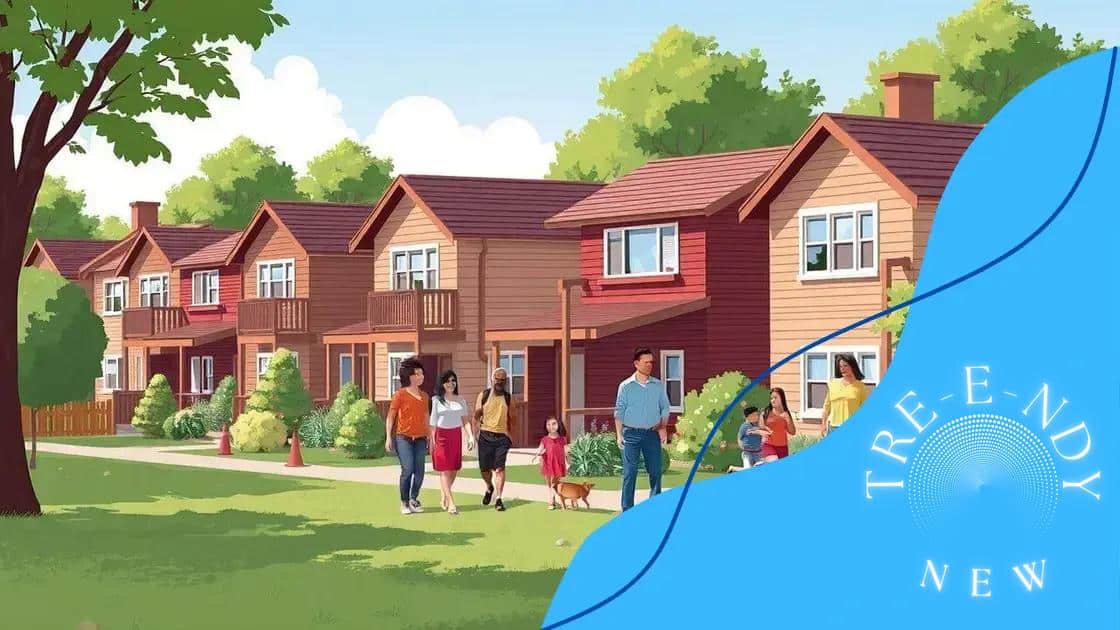Affordable housing funding programs: Unlocking opportunities

Affordable housing funding programs provide crucial financial support through government grants, tax credits, and community initiatives, enabling low- to moderate-income families to secure stable living conditions.
Affordable housing funding programs play a crucial role in providing essential support for those in need of stable and affordable living conditions. Are you aware of how these initiatives can help you or someone you know? Let’s dive into the potential benefits and resources available.
Understanding affordable housing programs
Understanding affordable housing programs is essential for anyone looking to gain insight into how these initiatives work. They aim to make housing accessible to individuals and families with low to moderate incomes. These programs offer various financial aids, enabling people to secure a stable living environment.
Types of Affordable Housing Programs
Several types of programs exist, each catering to specific needs within the community. Here are some of the most common:
- Public Housing: Operated by government entities, these properties are often rented at below-market rates.
- Section 8 Vouchers: This program allows eligible low-income families to rent housing in the private market using government assistance to cover some of the costs.
- Low-Income Housing Tax Credit (LIHTC): This program provides tax incentives to developers who create affordable housing units.
- Inclusionary Zoning: This approach requires a certain percentage of new developments to be affordable for low-income families.
Every program has its unique eligibility requirements, which can sometimes be complex. Keeping track of these conditions is crucial for those seeking assistance. For instance, income limits play a significant role in determining who qualifies for various programs. Additionally, programs may differ by state and locality, reflecting local economic conditions and housing needs.
Funding Sources for Affordable Housing
Understanding where the funding for these programs comes from can help clarify how they operate. Typically, funds are sourced from:
- Federal and state government allocations.
- Private investments and philanthropic donations.
- Community development financial institutions (CDFIs).
With these diverse sources, affordable housing programs can sustain their operations and continue to serve communities effectively. Besides monetary support, partnerships with non-profit organizations often enhance outreach and operational efficiency.
Engaging with local agencies can offer invaluable insights into available resources and how to access them. Many communities have outreach programs designed to educate potential applicants about their options and guide them through the application process. By understanding these elements, individuals can better navigate the often daunting landscape of affordable housing.
Key funding sources for affordable housing
Key funding sources for affordable housing are essential to understand for anyone involved in the development or assistance programs. These sources not only provide the necessary financial support but also drive the sustainability of housing initiatives aimed at low-income families.
Government Funding
Government agencies play a significant role in financing affordable housing projects. Programs at both the federal and state levels offer substantial resources. For instance, the U.S. Department of Housing and Urban Development (HUD) provides various grants and funding initiatives to developers and municipalities.
- Community Development Block Grants (CDBG): These grants fund housing and community development projects.
- HOME Investment Partnerships Program: This program offers grants to create affordable housing for low-income households.
- Low-Income Housing Tax Credit (LIHTC): A vital resource that incentivizes private investment in affordable housing.
Understanding these funds can help organizations and individuals leverage government resources effectively. Non-profit organizations often apply for these grants to implement community-driven housing solutions.
Private and Philanthropic Investments
In addition to government funding, private investors and philanthropic donations are crucial for affordable housing development. Various foundations and non-profits are committed to addressing the housing crisis through financial support and resources.
- Philanthropic Foundations: Many large foundations like the Ford Foundation and the Kresge Foundation support affordable housing initiatives through grants.
- Real Estate Investment Trusts (REITs): Some REITs focus on developing and operating affordable housing units.
- Crowdfunding Platforms: These platforms allow individuals to invest smaller amounts in housing projects, making it accessible for more investors.
Combining these funding sources helps create a comprehensive financial strategy for developing and maintaining affordable housing. By diversifying the funding streams, projects are more likely to succeed and provide long-lasting solutions for communities in need.
Ultimately, understanding the landscape of funding sources ensures that housing programs can appropriately target resources, making a real difference in the lives of those who need it most.
The role of government in housing finance

The role of government in housing finance is crucial for ensuring that affordable housing options are available to those in need. It involves various programs and policies that help support the development and accessibility of housing for low- to moderate-income families.
Government Programs
Many countries have specific government programs designed to facilitate housing finance. These programs often provide financial assistance or incentives to both developers and homebuyers. Some primary examples include:
- FHA Loans: The Federal Housing Administration (FHA) provides insurance on loans made by approved lenders, making homeownership more accessible for first-time buyers.
- VA Loans: The Department of Veterans Affairs (VA) offers benefits that support veterans in purchasing homes, often with no down payment required.
- USDA Loans: The U.S. Department of Agriculture (USDA) provides loans for rural property purchases, allowing low-income families in these areas to achieve homeownership.
These programs are vital for making homeownership feasible for many households that otherwise might struggle to find financing through traditional avenues.
Subsidies and Grants
The government also offers subsidies and grants to developers and nonprofit organizations involved in creating affordable housing units. Such financial support encourages the construction of housing that meets the needs of low-income individuals.
- Housing Trust Fund: A federal program providing funding to create, rehabilitate, and operate rental housing for extremely low-income households.
- Low-Income Housing Tax Credits: A program that provides tax incentives to private investors to encourage the development of affordable housing.
- Community Development Block Grants (CDBG): These grants assist in developing viable urban communities by providing decent housing and a suitable living environment.
Through these measures, the government plays a vital part in fostering an environment where affordable housing can thrive. By providing financing options and direct support, it addresses housing shortages and stabilizes communities.
Additionally, government policies impact zoning laws and other regulations, influencing how housing developments can proceed. Policymakers often debate the balance between growth and sustainability, which in turn affects the availability of affordable housing.
Success stories from funded housing projects
Success stories from funded housing projects illustrate how effective affordable housing initiatives can transform communities. These projects highlight the positive impact that financial support can have on families and individuals in need.
Project Examples
Many successful housing projects have emerged across the country, showcasing innovative solutions. One notable example is the Phoenix Housing Project in Arizona. This initiative provided homes for over 200 families, enabling them to access stable living conditions.
- Community Reinvestment Act projects: These initiatives aim to revitalize communities by providing safe and affordable housing.
- Green affordable housing: Some projects focus on sustainability, using eco-friendly materials and practices to reduce costs long-term.
- Mixed-income developments: These projects bring together various income levels, fostering economic diversity within neighborhoods.
Each of these examples demonstrates how targeted funding can lead to positive outcomes in housing and community stability. Residents often report greater satisfaction and a sense of belonging, which are essential for healthy communities.
Impact on Residents
Beyond just providing shelter, successful housing projects improve the quality of life for residents. Families gain greater access to essential services like healthcare, education, and employment opportunities. This holistic approach plays a crucial role in breaking the cycle of poverty.
Success stories often include personal accounts from residents who have benefited from these initiatives. For instance, a single mother might share how moving into affordable housing allowed her to focus on her education while providing a stable home for her children.
Moreover, funded housing projects often lead to community engagement. Residents participate in activities and decision-making processes that shape their living environment. This involvement not only fosters a sense of ownership but also strengthens social ties between neighbors.
How to apply for funding programs
Applying for funding programs can seem overwhelming, but understanding the process is key to success. Knowing the steps and requirements can help you navigate through and secure the financial support needed for affordable housing projects.
Researching Available Programs
The first step in applying for funding is to research what programs are available. Various federal, state, and local options exist, each with its own eligibility criteria and application process.
- Local Housing Agencies: Start by checking with local housing authorities. They often have programs tailored to specific community needs.
- Government Websites: Websites like grants.gov have comprehensive databases listing federal funding opportunities.
- Non-profit Organizations: Many non-profits offer funding assistance or can help guide you through the application process.
Gathering information from these sources can streamline your application efforts and ensure you choose the right program.
Preparing Your Application
Once you have identified the appropriate funding program, it’s important to prepare your application thoroughly. Applications often require detailed information, including:
- Project Description: Clearly outline the goals and objectives of your project.
- Budget Proposal: Include a detailed budget that shows how the funds will be utilized.
- Supporting Documents: Gather necessary documents such as income statements, feasibility studies, or letters of support from community members.
Ensuring your application is complete and well-organized can significantly improve your chances of funding approval.
Be mindful of deadlines as well. Many programs have specific application windows, and late submissions may not be considered. Keep a calendar and set reminders for critical dates to help stay organized.
Follow Up and Stay Engaged
After submitting your application, it’s essential to follow up. Check in with the funding body to confirm they received your materials and ask about the timeline for decisions. This proactive approach can also show your commitment to the project.
Finally, engage with your community throughout the process. Share your plans and invite feedback, which not only strengthens your project but also builds local support. This community backing can be appealing to funders when reviewing applications.
In conclusion, understanding and navigating affordable housing funding programs is essential for making a meaningful impact in our communities. From researching available programs to preparing strong applications, each step plays a vital role in supporting families in need. By engaging with local agencies and communities, we can foster positive change together. Remember, every successful housing initiative begins with knowledge and action!
FAQ – Frequently Asked Questions about Affordable Housing Funding Programs
What are the main types of funding available for affordable housing?
The main types of funding include federal grants, state programs, tax credits, and community development initiatives that support building and maintaining affordable housing.
How can I find available affordable housing funding programs?
You can find programs by visiting government websites, checking with local housing authorities, and consulting non-profit organizations focused on housing.
What documents are typically required for applying for funding?
Common documents needed include a project description, a detailed budget proposal, and supporting documents such as income statements and letters of support.
How important is community engagement in housing projects?
Community engagement is crucial, as it fosters support and collaboration, ensuring that housing initiatives meet local needs and enhance community well-being.





